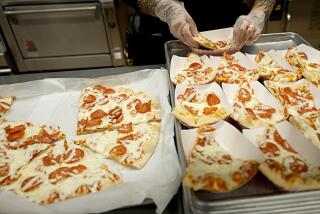U.S. Seeks to Fortify Troops With Tastier Field Cuisine
- Share via
DESERT FIRING RANGE 8, Kuwait — As the U.S. military masses in this region for a possible war with Iraq, much of the talk is about improvements in weaponry since the 1991 Persian Gulf War: more accurate artillery, faster tanks and precision-guided munitions.
Half a world away in a Boston suburb, civilian employees of the Defense Department are convinced that they also have contributed to a quantum leap in American military prowess in recent years.
In an undertaking unnoticed among more high-profile projects, the military has spent the last decade improving its field rations: the much-maligned meals ready to eat, derided by troops during the 1991 war as “meals rejected by everybody.”
“These are not your father’s MREs,” said Gerald Darsch, director of the military’s Combat Feeding Program in Natick, Mass. “To compare the Desert Storm MRE to today’s MRE is like comparing a beef patty to prime rib.”
One of the more eagerly awaited “after action” reports once U.S. troops leave this region is likely to be whether the military succeeded in making its MREs more palatable. Congress, sensitive to complaints about food at the front, is watching.
After the Gulf War, the military was determined to upgrade the MRE with food that was tastier, more varied and easier to heat. During Operation Desert Storm, troops had a selection of half a dozen menus. Now, there are two dozen, with more in the development stage.
Selections that scored poorly on troop surveys -- among them the notorious ham-and-chicken loaf and the tuna with noodles -- were dropped. Those that scored highly -- including chicken tetrazzini -- were added.
A better system has been developed to heat the entrees. A major gripe during the 1991 war was that the method was troublesome and frustrating. And a cold MRE back then, Darsch says, was a frightful excuse for a meal.
Introduced in the early 1980s, the MREs replaced C rations. Those small tins of food, including Spam, sustained troops in the field during World War II, Korea and Vietnam.
The new MREs, at a cost to taxpayers of $6 to $8 each, come in sealed, lightweight pouches. The food and pouches are designed to last for years and to withstand the jostling, pounding and temperature changes common in military transportation.
In the testing phase, pouched MREs are dropped from helicopters, thrown off speeding trucks and stored at 100 degrees. Testing is meant to ensure that only the supple and tasty survive.
The goal is to provide troops with enough calories to keep them alert and robust and with enough variety to keep morale from drooping.
“In Desert Storm, menu fatigue and menu monotony became critical issues,” Darsch said. “We want our war fighter to have the best.”
Each MRE has an entree to be warmed by a chemical-laced strip. The drill is simple: Slip the pouch into the plastic heater package, add water to activate the strip, shake vigorously and wait a minute.
In many of the larger Army and Marine Corps camps spread over the desert here, hot food is available through combat kitchens. In the field, however, MREs are the staple.
Each has a variety of candies and snacks. The only utensil is a plastic spoon. In each packet is a bag containing matches, salt, a moist towelette, dry tea, dry cider, gum, toilet paper and a 1-ounce bottle of Tabasco sauce.
In the field, talk of food is a constant. Marines and soldiers acquire collateral skills as food critics. They swap ad hoc recipes on how to combine ingredients. “Ranger pudding,” for example, can be made by combining poundcake and cocoa powder.
“There are a thousand recipes,” said Marine Sgt. Colin Wyers, 21, of Davenport, Iowa, whose favorite MRE is beef ravioli and whose least favorite is Thai chicken -- soon to be replaced by a chicken fajita.
One favorite of Desert Storm troops has been dropped: the chocolate bar that acquired the motto “Melts in your mouth, not in the desert.” Over the long haul, the bar was unable to withstand the temperature swings on cargo ships and planes.
The military has developed an energy bar, the HooAH!, but it has not yet won a place in the MRE lineup. Company commanders, however, have the option of ordering cases.
Ask troops to rate the MRE menus, and the debate is immediate and brisk.
“The old beef enchilada with mushroom was good, not the new one with rice pilaf,” said Marine Cpl. Clifton Singleton, 23, of New York City. “The wheat snack is good, but those crackers are nasty.”
Is there griping about MREs? You might as well ask whether there are hard feelings toward Saddam Hussein. But veteran soldiers and Marines say their younger comrades lack the proper context to appreciate the little brown plastic pouches.
“They just don’t know how good they’ve got it,” said Marine Gunnery Sgt. Robert McCarty, 37, from New Jersey, an 18-year veteran. “I got a slice of ham infested with maggots in 1985. That’s the kind of thing you never forget.”
The MRE packaging has uses never intended by employees at the U.S. Army Soldier Systems Command back in Massachusetts. Stuff a heater inside a bottle of water, seal the cap, shake vigorously and, voila, “MRE bomb,” as the gas rises and pops off the cap. Perfect for morale-boosting pranks.
The cardboard containers for entrees can be used as targets for M-16 practice, as scratch pads and, if toilet paper runs low, for a purpose known in military jargon as a “field expediency.”
Improvements notwithstanding, there is one hurdle that MREs will never surmount.
“I’d rather have my mother’s cooking in a heartbeat,” said Marine Lance Cpl. Tan Mai, 19, of San Jose.
More to Read
Sign up for Essential California
The most important California stories and recommendations in your inbox every morning.
You may occasionally receive promotional content from the Los Angeles Times.













